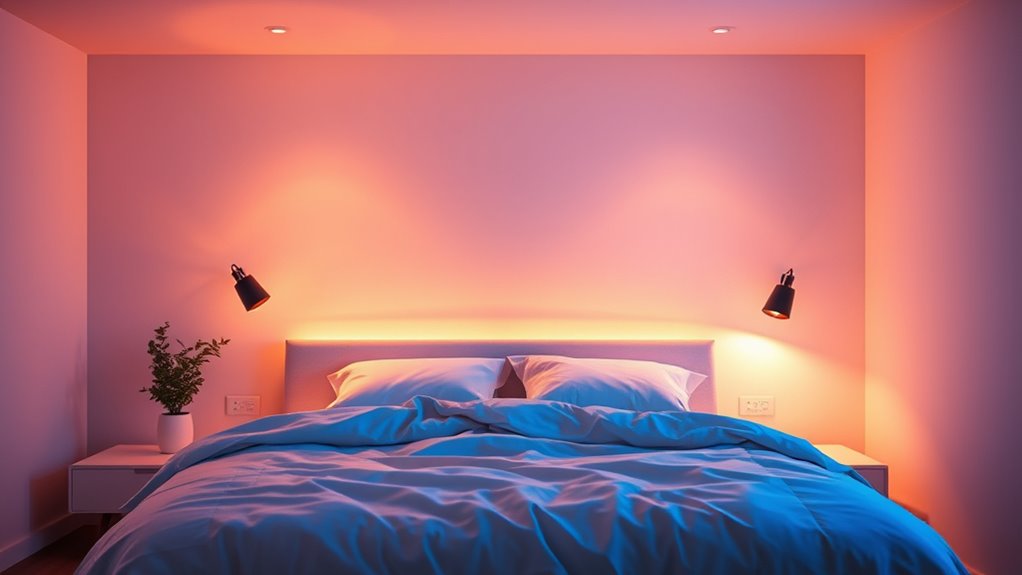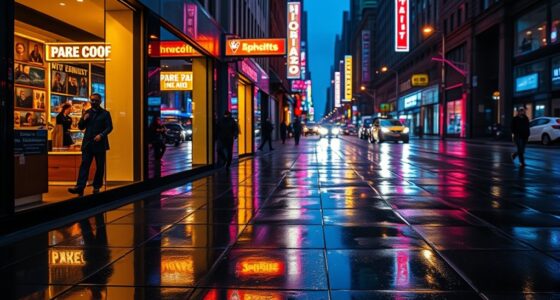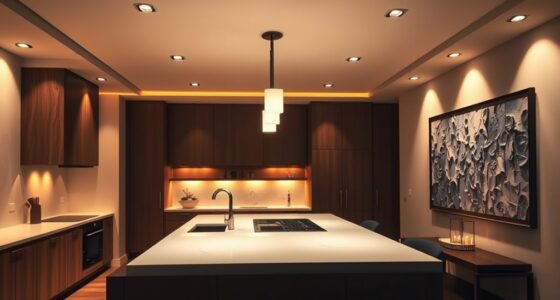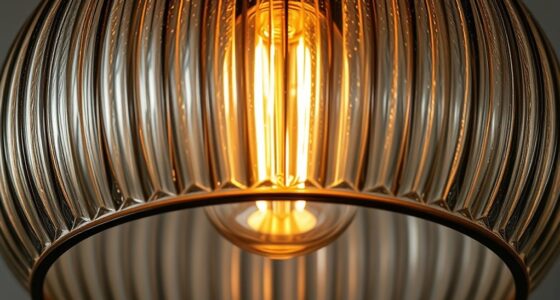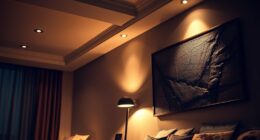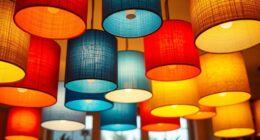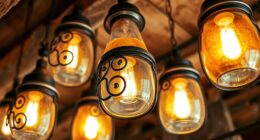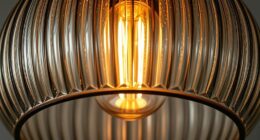Adjusting your lighting’s color temperature throughout the day can help support your sleep by syncing with your natural circadian rhythms. During the day, use cooler, blue-enriched lights (5000K-6500K) to boost alertness and mimic natural sunlight. As evening approaches, switch to warmer, softer lights (2700K-3000K) to signal your body it’s time to wind down. Proper timing and gradual changes in lighting help improve sleep quality and overall well-being—learn more to optimize your environment.
Key Takeaways
- Using warmer, lower color temperatures (2700K-3000K) in the evening promotes melatonin production and prepares the body for sleep.
- Cooler, higher color temperatures (5000K-6500K) during the day enhance alertness by mimicking natural daylight.
- Gradually shifting lighting from cool to warm tones helps signal the transition from wakefulness to sleep.
- Automated lighting systems can adjust color temperature throughout the day to support circadian rhythms.
- Proper timing of light exposure reinforces natural internal clocks, improving sleep quality and overall health.
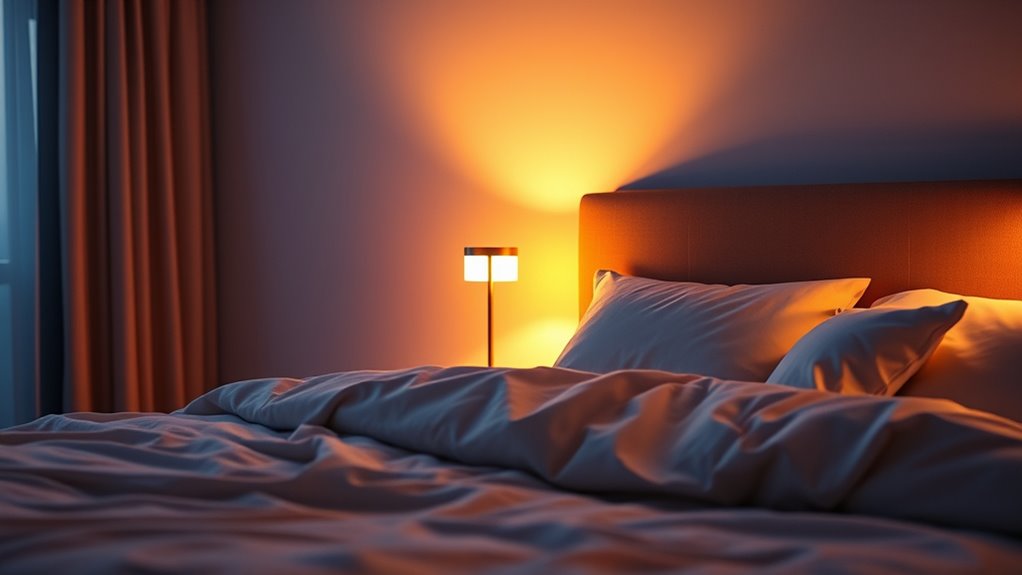
Have you ever wondered how lighting affects your body’s internal clock? Your circadian rhythm, the natural cycle that regulates sleep, wakefulness, and many other biological functions, is deeply influenced by the light around you. Proper lighting, especially in indoor environments, can support or disrupt these biological rhythms. That’s where circadian lighting comes into play. By adjusting the color temperature of lights throughout the day, you can help synchronize your internal clock, promoting healthier sleep patterns and overall well-being.
Lighting influences your internal clock, supporting healthy sleep and biological rhythms through strategic color temperature adjustments.
Light therapy is a key tool in this process. It involves exposure to specific types of light, often bright and blue-enriched, during the day to reinforce your natural rhythms. When you receive this kind of light at appropriate times, it signals your brain to suppress melatonin production, making you feel alert and awake. Conversely, as evening approaches, reducing the blue light and shifting to warmer, lower color temperatures encourages melatonin release, helping you unwind and prepare for sleep. This strategic manipulation of light helps keep your biological rhythms aligned with the external environment, preventing issues like insomnia or seasonal affective disorder.
Adjusting the color temperature of your lighting isn’t just about brightness; it’s about creating an environment that mimics natural daylight patterns. During the morning and early afternoon, brighter, cooler lights with higher color temperatures (around 5000K to 6500K) can stimulate alertness, much like the midday sun. As evening approaches, shifting to warmer, softer lights (around 2700K to 3000K) mimics sunset lighting, signaling to your brain that it’s time to wind down. This gradual shift helps your body prepare for sleep, making it easier to fall asleep and improving sleep quality overall.
When you integrate circadian lighting into your daily routine, you’re fundamentally supporting your body’s internal clock with the right type of light at the right time. This approach can boost your mood, enhance productivity during the day, and improve your sleep at night. Many smart lighting systems now enable you to automate this process, adjusting color temperature throughout the day automatically, so you don’t have to think about it constantly. By paying attention to how your light environment changes, you can foster a healthier, more synchronized biological rhythm, leading to better energy levels and overall health.
In reality, understanding and controlling your lighting environment isn’t just about aesthetics; it’s a powerful way to support your body’s natural biological rhythms. Properly timed light therapy and circadian lighting can help you feel more alert when needed and more relaxed when it’s time to sleep. This harmony between light and your internal clock can greatly improve your quality of life, making it a simple yet impactful step toward better health and well-being. Incorporating personalized lighting solutions can optimize your environment even further for better health outcomes.
Frequently Asked Questions
How Quickly Does Circadian Lighting Influence Sleep Patterns?
You can notice the effects of circadian lighting on your sleep cycle within days. As your light adapts to natural changes, it helps regulate your sleep patterns by signaling your brain to wind down or wake up. Consistent exposure to appropriate color temperatures, especially in the evening, quickly influences your sleep cycle, promoting better sleep quality. Over time, this adjustment supports healthier sleep habits and overall well-being.
Can Circadian Lighting Reduce Symptoms of Jet Lag?
Yes, circadian lighting can help reduce jet lag symptoms. By mimicking natural light patterns, it acts like light therapy, helping your body regulate melatonin levels. This adjustment supports your internal clock, easing the change across time zones. Using properly timed light exposure, you can reset your circadian rhythm faster, making you feel more alert during the day and helping you sleep better at night, consequently alleviating jet lag effects.
Is Circadian Lighting Effective for Shift Workers?
Yes, circadian lighting is effective for shift workers. Studies show it can improve workplace productivity by up to 15% and enhance mental health benefits. By adjusting color temperature to mimic natural light, you help regulate your internal clock, reducing fatigue and improving alertness during night shifts. This lighting strategy supports better sleep during off-hours, boosting overall well-being and performance in demanding work schedules.
What Are the Best Color Temperatures for Evening Use?
For evening lighting, you should aim for a warmer color temperature, around 2700K to 3000K. This range creates a cozy, relaxing atmosphere that helps your body prepare for sleep. Warmer hues reduce blue light exposure, which can interfere with melatonin production. Use dimmer lights in this range during the evening to support your natural circadian rhythm and promote better sleep quality.
Are There Any Health Risks Associated With Improper Lighting Adjustments?
Imagine your eyes as delicate windows to your health—improper lighting can fog that view. Yes, exposure to blue light from screens and bright lighting at night can cause retinal damage over time. Poorly adjusted lighting may also disrupt your sleep, leading to health risks like fatigue or weakened immunity. To protect yourself, limit blue light exposure in the evening and use warmer lighting to support your circadian rhythm.
Conclusion
By adjusting your lighting to match your natural rhythms, you’re like a skilled conductor guiding your body’s symphony of sleep and wakefulness. When you use circadian lighting, you’re not just changing colors—you’re orchestrating a healthier, more restful life. Embrace these subtle shifts in your environment, and watch how they brighten your days and soften your nights. After all, your sleep quality is the canvas, and proper lighting is the brush that paints your well-being.
